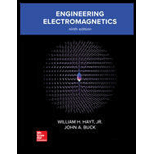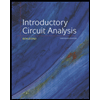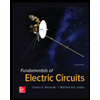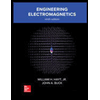
Concept explainers
At large distances from a dipole antenna (to be addressed in Chapter 14), the electric field amplitude that it radiates assumes the simplified form
where A is a constant. A second dipole antenna, receiving radiation from the first is located at distance r from the first, has length L, and is oriented along the aθ direction, thus presenting its full length to the transmitting antenna at the origin. The angular position of the receiving antenna is θ = θ0, As observed from the transmitting antenna, the receiving antenna subtends angle AG. (a) Find the voltage amplitude across the length of the receiving antenna, and express your result in terms of A, Q0, L, and r. (b) Specialize your result for the case in which L <
Want to see the full answer?
Check out a sample textbook solution
Chapter 4 Solutions
Engineering Electromagnetics
- An antenna radiates a total power of 100W in the direction of maximum radiation, the field strength at a distance of 10Km was found to be 12mV/m. What is the gain of the antenna? Assume free space propagation. If η=90% find directivity.arrow_forwardA dipole is composed of a pair of point charges ±?, separated by a distance ?d and aligned parallel with the ?-x-axis, as shown in the figure. Find the expression for the potential ? on the ?-axis at point F located at ?=3.77×10−8 cm, where ?≫?. Then, evaluate the potential for a dipole moment of ?=8.00×10−30 C·m. The Coulomb force constant is ?=1/(4??0)=8.99×109 N·m2/C2.arrow_forwardConsider the electric dipole shown in the figure below, formed by two charges, one of which is positive with charge +q and the other negative with charge -q, separated by a distance d. Find the total electric field at a point P on the axis of the dipole, at a distance from its center. Make an analysis of the electric field value for points far away from the dipole. answer found:4k qd/x³arrow_forward
- A slab of dielectric material has a relative dielectric constant of 3.8 and contains a uniform electric flux density of 8nC/m^2. If the material is lossless; find: (a)E; (b)P; (c)The average number of dipoles per cubic meter (n) if the average dipole moment is p=10^-29Cmarrow_forwardA dipole having a moment p = 3ax − 5ay + 10az nC · m is located atQ(1, 2,−4) in free space. Find V at P(6, 3, 4).arrow_forwardAn electric field propagates along the z-direction and has only one component along the x -axis. It can be generally described by the equation (phasor form): Ex = E+ exp (-jbz) + E- exp (+jbz) At z=0, there is a mirror (perfect conductor); using the boundary condition Ex =0 at z=0, find: The relation between E- and E+ , also known as the “reflection coefficient”. The time expression of the total electric field for z < 0, assuming an angular frequency w. The distance between the maxima and minima of the electric field. (THIS PROBLEM IS ENTIRELY EQUIVALENT OF AN IDEAL TRANSMISSION LINE SHORT-CIRCUITED AT Z= 0).arrow_forward
- A circle has a center at the origin and has a radius of R. If x = 10 and y = 20, determine the slope of the particular orthogonal trajectory at this point.arrow_forwardA horizontal infinitesimal electric dipole of constant current I0 is placed symmetrically about the origin and directed along the x-axis. Derive the(a) far-zone fields radiated by the dipole(b) directivity of the antennaarrow_forwardAn infinitesimal magnetic dipole of constant current Im and length l is symmetrically placed about the origin along the z-axis. Find the (a) spherical E- and H-field components radiated by the dipole in all space(b) directivity of the antennaarrow_forward
- Example: A 31/4dipole is radiating into free-space. Input power to the dipole is 100 W. Assuming an overall efficiency of 50%, find the power density (in W/m?) at (r = 500 m, 8 = 60°, ¢ = 0)? Solution:arrow_forwardAn antenna with power P= 2.2 x 10^3 W is radiating spherical electromagnetic waves. Consider a place which is d = 820 m away from the antenna. - Express I in terms of the electric magnitude Emax, the speed of light c, and the permeability of free space U0. AND - Solve for the numerical value of Emax in volts per meter.arrow_forwardA slab of dielectric material has a relative dielectric constant of 3.8 and contains a uniform electric flux density of 8nC/m^2. If the material is lossless; find: The average number of dipoles per cubic meter (n) if the average dipole moment is p=10^-29Cmarrow_forward
 Introductory Circuit Analysis (13th Edition)Electrical EngineeringISBN:9780133923605Author:Robert L. BoylestadPublisher:PEARSON
Introductory Circuit Analysis (13th Edition)Electrical EngineeringISBN:9780133923605Author:Robert L. BoylestadPublisher:PEARSON Delmar's Standard Textbook Of ElectricityElectrical EngineeringISBN:9781337900348Author:Stephen L. HermanPublisher:Cengage Learning
Delmar's Standard Textbook Of ElectricityElectrical EngineeringISBN:9781337900348Author:Stephen L. HermanPublisher:Cengage Learning Programmable Logic ControllersElectrical EngineeringISBN:9780073373843Author:Frank D. PetruzellaPublisher:McGraw-Hill Education
Programmable Logic ControllersElectrical EngineeringISBN:9780073373843Author:Frank D. PetruzellaPublisher:McGraw-Hill Education Fundamentals of Electric CircuitsElectrical EngineeringISBN:9780078028229Author:Charles K Alexander, Matthew SadikuPublisher:McGraw-Hill Education
Fundamentals of Electric CircuitsElectrical EngineeringISBN:9780078028229Author:Charles K Alexander, Matthew SadikuPublisher:McGraw-Hill Education Electric Circuits. (11th Edition)Electrical EngineeringISBN:9780134746968Author:James W. Nilsson, Susan RiedelPublisher:PEARSON
Electric Circuits. (11th Edition)Electrical EngineeringISBN:9780134746968Author:James W. Nilsson, Susan RiedelPublisher:PEARSON Engineering ElectromagneticsElectrical EngineeringISBN:9780078028151Author:Hayt, William H. (william Hart), Jr, BUCK, John A.Publisher:Mcgraw-hill Education,
Engineering ElectromagneticsElectrical EngineeringISBN:9780078028151Author:Hayt, William H. (william Hart), Jr, BUCK, John A.Publisher:Mcgraw-hill Education,





